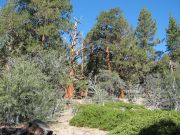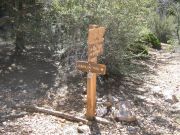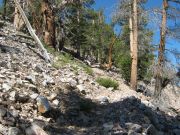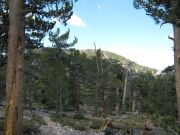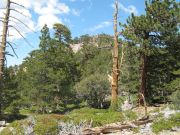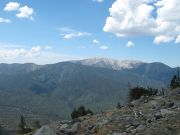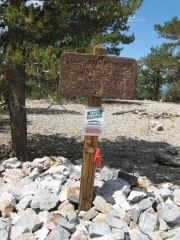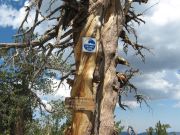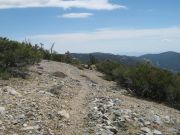
The Mountains of California
www.surgent.net |
| Sugarloaf Mountain |
• San Bernardino Mountains • San Bernardino National Forest • San Bernardino County |
|
Date: August 9, 2012
• Elevation: 9,952 feet
• Prominence: 1,952 feet
• Distance: 7 miles
• Time: 3 hours
• Gain: 1,400 feet
• Conditions: Humid, cloudy, storm brewing as I descended
California
•
Main
•
PB
Sugarloaf Mountain is a major summit in the San Bernardino Mountains, a peak that reaches just shy of 10,000 feet (its elevation is 9,952 feet). It is also the second-most prominent mountain in the range. Despite these near-superlatives, Sugarloaf is a mere bump when compared to its gigantic neighbor, Mount San Gorgonio. Nevertheless, Sugarloaf stands tall from certain vantage points, especially in the town of Big Bear Lake, where the peak rises high south of the town and the lake.
I had not hiked at all this summer, other than a short hike last month on Greens Peak in Arizona. With the school year starting again soon, I really wanted to get away for a few days. I had a whole bunch of peaks in the San Gabriel and San Bernardino Mountains that interested me. I was looking to hike a few peaks on the Sierra Club's Hundred Peaks List as well as those that were most prominent within the ranges. Sugarloaf fit the bill, and it features a good trail with about 7 miles of walking, so it wouldn t be an all-day grunt, but would still get me some good exercise.
The high temperature in Phoenix was 116 degrees the day before I left, and my truck has no air conditioning, so I left the following morning at 1 a.m., crossing the desert on Interstate-10, which worked well. By early morning I had arrived in the Yucaipa-Redlands area of Southern California. I exited, got basic supplies, topped the gas, and proceeded eastbound on state route CA-38, the plan being to visit Sugarloaf first, then drive into Big Bear and hike a couple quick peaks there, then exit via state routes CA-18 or CA-330 toward my parents' place in Wrightwood.
My journey was delayed about 30 minutes as the highway was closed shut while crews cleared out the wreckage from a head-on collision. Everyone sat in their cars, engines off, just waiting for the all-clear. They re-opened the road at 8 a.m., thus begetting a traffic jam of dozens of vehicles starting the slow roll up the single lanes of the highway. Me, I pulled off early into the nearby ranger station to let the cars pass and get some Adventure Passes for my various journeys. Once back on the road, I saw one of the vehicles involved in the wreck being loaded onto a flat-bed. Its cab was mostly intact, which (I hope) meant positive news for the occupant. I have no way of knowing the outcome of that accident. I hope they re okay.
I made good time up the highway, but invariably got in behind a slow truck, where all of us would pass this slowpoke at the occasional passing lanes only to get in behind another slow truck. Soon, cars would veer off onto side roads, or into the small towns along the route (such as Angelus Oaks) so that after about 25 miles of twisty mountain-road driving, I was essentially on my own as I neared my objective. I found Wildhorse Meadows Road at about milepost 35, a mile or so beyond the Heart-Bar campground. This road would be my access to the start of the hike.
Wildhorse Meadows Road is a narrow dirt road cut into the side of the hills, a little torn up and chunky at first, but after a mile or so, it smoothed out reasonably well. In spots it was one car-width wide, but I wasn t expecting anyone on this day. I slowly rumbled the six miles up this road to where the road entered into an elevated valley with pretty grassy meadows ringed by mature forest. I made an error in not noting my mileage exactly, and thus wasted about 10 minutes checking out the "gated roads on the left" that the Sierra Club HPS website says is the start of the hike. I found it, and yes, it was exactly where the guide said it would be, had I paid more attention to my odometer. After 350 miles and eight hours of driving, I was finally ready to kill the engine and start walking. Conditions here, at about 8,700 feet, were pleasant and still.
I started my hike at 9:20 a.m., walking through an opening in the fence line and meeting the trail about 20 feet farther on. I walked upwards on the trail, bypassing two large downed trees, then gaining steeply up one small segment to where the trail now had achieved the main ridge. I had walked about a half mile and gained about 200 feet. The summit was just three miles west, all ridge-walking from here on out
The trail stays on the ridge, sometimes meandering in and out with the trees, including some very impressive and large specimens, suggesting this immediate area hasn t seen a fire in a very long time. After about another 20 minutes, the route drops about 80 feet and meets up with an old road from one side, and a trail from the other. A sign points the way to the summit. After a short rest, I continued onward.
The trail is actually a two-track or ATV-track for a little while before narrowing again into a proper trail. It gains at a moderate grade, working its way up toward a ridgepoint, elevation 9,348 feet. Here, I felt the effects of not hiking for a long time, and of the elevation, and I was forced to take a longer rest break here. I really felt out of it for awhile there. Rested, I continued upward. The trail comes out to the main ridge again, then starts up another moderately-steep segment to gain onto a flattish segment between ridgepoints 9,702 and 9,775. By now, the trail is covered in fist-sized rocks that, while generally solid, do like to move out from under my boots. After a pleasant flat stretch on this mini-plateau, the trail drops about a hundred feet to a saddle at about 9,600 feet, then from here makes the final easy push up to the actual summit.
For the last half of my ascent I was growing somewhat concerned about the puffy clouds that were building. When I achieved the summit and its rock piles and signs, the skies above me were a mix of blue and of puffy clouds, while north of me, nearer Big Bear Lake, actual thunderheads had already amassed. I enjoyed my 10 minutes on the summit, which is very broad and offers no great views. I signed into the register and shot a few photos, but just as fast, objective done, I started the trek back down.
The egress went well and I didn t stop at all. Distant thunder rumbled from the thunderheads near Big Bear, but I had mostly sunny weather and warm temperatures as I hiked down the ridge and back to my truck. The out-hike took an hour exactly, and I was back to my truck at 12:30 p.m., a three-hour journey. I felt tired but energized, happy to have hiked again after so many weeks of inactivity. Looking back, Sugarloaf's summit area was now covered over in these dark, ominous clouds. I didn t waste time, and I drove down the Wildhorse Meadows Road before any rains came.
From here, I drove about another 15 miles into Big Bear Lake and its various surrounding communities. I had two more easy peaks on the agenda, Delamar and Butler Peaks, both close by and very easy, but by now, it was raining and lightning. There was no way I was going to hike in these conditions. I drove into Fawnskin and thought about waiting out these storms, but after about 30 minutes, decided to cancel these hikes for another time. Big Bear Lake is notable for being in the opening segment of the H.R. Pufnstuf television show from the late 1960s. I thought that was amusing.
It was nearing 2 p.m., so I left Big Bear and drove west on CA-18 into the town of Running Springs, where I had plans to drive and make a short hike up Keller Peak. The storms seemed to be moving on and I hoped to get in this simple summit before the day was over.
|
|

